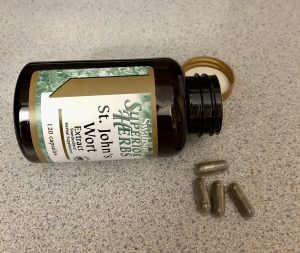One of my coworkers and I were talking about research projects we had done in school, many moons ago. She said she'd done one on what was growing in her makeup and had been surprised at the results. She also won the Science Fair with that project that year.
Now I confess that I always knew that makeup companies recommended purchasing new makeup every so often, usually before it had run out. I had always thought that it was because they wanted to sell more makeup! I'm in the medical profession, and I do know about sterile technique and keeping bandages and topical medications from being contaminated, but I didn't really take the idea of bacteria growing in my makeup seriously.
Enterococcus Faecalis This bacteria lives in the gut, bowels, and occasionally in the mouth or vagina. In normal, healthy people, and unless it spreads to other areas of the body, this bacteria is usually no problem in normal amounts. But in people with compromised immune systems, such as the elderly, people in hospitals, pregnant ladies or infants, or people with AIDS it can be a huge problem causing lovely illnesses like bacteria, urinary tract infections, meningitis, infections in the mouth, especially with root canals, and infections in the lining of the heart. It has been found on all old makeup products including foundation, lip gloss, and lipstick, and on your makeup brushes and sponges.
Aeromonus This rod shaped bacteria can be found in fresh and brackish waters, or in soil. It can cause gastroenteritis, wound infections, necrotizing fasciitis, or cellulitis.
Staphylococcus Epidermis This bacteria grows on the skin, axillae, and nares, and is thought to assist our bodies in fighting its nastier cousin, Staphylococcus Aureus. In large amount, it can cause infections of surgical implants, infection of a catheter, infections of the lining of the heart (endocarditis). Because it lives on the skin in such abundance, it is resistant to many antibiotics. It can be found on lipstick, eyeshadows, and eyeliners, as well as on your makeup tools, like sponges or brushes.
Staphylococcus Aureus This bacteria can be found in old makeup products. It can live on your skin and enter a pimple, the mucus membranes of the nose or eye causing pink eye, redness, inflammation, a rash or dermatitis. Staphylococcus aureus can become resistant to many antibiotics and become MRSA- Methicillin Resistant Staph Aureus.
Eubacterium This bacteria has been associated with bacterial vaginosis, and can infect root canals. It lives in the human intestinal tract and can be found in feces.
Enterobacteria These bacteria are found in the intestinal tract and can be found in feces. They can cause urinary tract infections and respiratory tract infections and are especially dangerous for people in hospitals or who have a compromised immune system
Propionibacterium This bacteria is one of the main causes for acne and other skin conditions and can be found in foundations, powders, and on your makeup brushes.
Pseudomonas Aeruginosa This bacteria is commonly found in soil, water, plants, and on the skin. It can cause inflammation and infections on the skin, eyes, or ears. Less commonly, it can infect the brain, liver, bones, and sinuses. It is typically found in hot tubs that have not been properly chlorinated. It can often be found on mascara wands.
Streptococcus Group A Streptococcus usually lives in the throat and in the skin, and is not harmful to most people unless it invades a part of the body where it is not native, like the lungs, fat tissue, or blood. At its worst, it can cause necrotizing fasciitis or toxic shock syndrome. Less serious illnesses include strep throat and impetigo. It is spread through contact with mucus from the nose or throat of an infected person.
How Can I Keep My Risk of Infection Down?
The University of Kansas Medical Center recommends that you replace your mascara every 3-4 months. Throw away your foundation every year and buy something new. Your eyeshadow should be replaced every 2 years. Lipstick and gloss should be replaced every year. Liquid eyeliners should be replace every 3 months, but pencil eyeliners can last one year after being opened.
Many products have a symbol of an open jar with a specified amount of time that states how long after opening they should last.
What Else Can I Do?
Washing your hands thoroughly before applying makeup is the most important and easiest way to prevent contamination of your makeup. (It always comes back to that, doesn't it?) The less often you touch your cosmetics with your hands or with a brush or sponge, the less likely you are to contaminate your makeup.
You may want to consider a foundation that comes from a tube, rather than a bottle or jar. You could use a clean sponge to apply your foundation, or you could pour a little makeup on a sponge and use your fingertips to apply it. Wiping a lipstick or an eyeliner pencil after every use can remove bacteria that are sitting on the top. You could also wipe the top of an eye shadow with a tissue, or possibly spray it with alcohol to remove surface bacteria.
Cleaning your brushes and sponges with warm water and sudsy soap at least once a week is also helpful. Don't forget to use an antibacterial wipe to clean the brush handles. Clean out your makeup bag with soap and water or an antibacterial wipe, and clean out your makeup drawer.
Conclusion
While most of us will not contract the more serious diseases from the bacteria in our makeup, knowing about the possibilities from bacteria in old makeup should make us think. And certainly fresh, new makeup looks better than the old outdated make up!
Blessings and Peace,
Jill

 Maybe you have never been an exerciser and figure it's too late to start. Well, you should definitely check with your doctor before starting a new exercise program, especially if you're over 40, just to make sure your joints and your heart okay. Your doctor or health care provider can give you some ideas on what types of activities would be best for you, and which are likely to cause problems. But for most people, it's never too late to start if you're willing to take it slow in the beginning and increase gradually.Consistency is one of the biggest factors. Most of us are really motivated in the beginning, but it gets harder to keep it up. It may be easier to have an exercise partner to help keep you motivated. And the best exercise buddy might be your dog. Dogs never complain about the route you take, and they don't cancel plans. In fact, they are so excited to go with you, that their energy is contagious. With 52% of dogs overweight or obese, your canine friend could probably use some of those aerobic benefits too!Just be careful about which exercise types are good for your dog. Small dogs may not be able to keep up with a runner, and some large breeds have hip dysplasia, making long runs painful for them. Dogs with flat faces may have trouble breathing if they work too hard. Dogs that are too young may damage their joints or bones by running on a hard surface if they are not done growing. Check with your vet for ideas on which exercises would be best for your dog. Keep it fun and enjoy the extra time and bonding with your furry friends.
Maybe you have never been an exerciser and figure it's too late to start. Well, you should definitely check with your doctor before starting a new exercise program, especially if you're over 40, just to make sure your joints and your heart okay. Your doctor or health care provider can give you some ideas on what types of activities would be best for you, and which are likely to cause problems. But for most people, it's never too late to start if you're willing to take it slow in the beginning and increase gradually.Consistency is one of the biggest factors. Most of us are really motivated in the beginning, but it gets harder to keep it up. It may be easier to have an exercise partner to help keep you motivated. And the best exercise buddy might be your dog. Dogs never complain about the route you take, and they don't cancel plans. In fact, they are so excited to go with you, that their energy is contagious. With 52% of dogs overweight or obese, your canine friend could probably use some of those aerobic benefits too!Just be careful about which exercise types are good for your dog. Small dogs may not be able to keep up with a runner, and some large breeds have hip dysplasia, making long runs painful for them. Dogs with flat faces may have trouble breathing if they work too hard. Dogs that are too young may damage their joints or bones by running on a hard surface if they are not done growing. Check with your vet for ideas on which exercises would be best for your dog. Keep it fun and enjoy the extra time and bonding with your furry friends.



